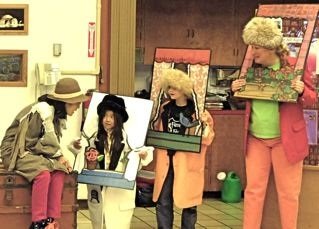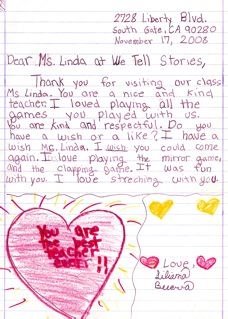I’ve been a touring children’s theatre artist with We Tell Stories for a decade. I’ve had an opportunity to go into so many schools, big ones and small ones. I’ve been into schools with airport style metal detectors, and I’ve been into schools with attached theatres that were grander than any of the theatres at the university I attended. I’ve been into schools whose students had never before seen a play. I’ve had principals tell me that their students hadn’t even been to the ocean, because the parents in the area were just too poor for outings. I’ve been amazed by the creativity and willingness of children to reach the bar set for them.
Last fall I was performing one early morning at a small school in East Los Angeles. The school was up a winding hill and stuck in the middle of a poor surrounding neighborhood. I checked in at the office and then found my way to the auditorium, which was also a classroom for a teacher. The auditorium consisted of a tiny stage, some folding chairs, and a couple of mats near the stage. Their space was so limited, all space had to be utilized. The off-stage space was being used as an office on one side and a storage room on the other. The teacher who taught in the space greeted us. One of my fellow actors asked where she could buy a soft drink, perhaps in the teacher’s lounge. The teacher told her, “We’re a poor school. We don’t have a soda machine. We don’t even have a true cafeteria. The meals for our students are brought into us everyday.”
The students started filing into the auditorium, and a group of rambunctious boys sat on the mats at the front of the stage. The boys were in third grade, but were trying to appear older, more mature. One boy had a mohawk, which was falling to the side of his face.
“Hey,” the boys asked me, “what are you doing here today?”
“We’re going to be telling three stories,” I said.
They noticed the props and costumes surrounding our trunk in the center of the stage.
“Do you have any guns in the show?” they chimed in. “We like guns.”
“Do you have any fights in these stories?” one of the boys piped in.
“No, we don’t have any guns in the show or violence.”
I felt uncomfortable with their questioning. I knew the boys were only being eager and curious, but it felt strange and inappropriate to have third graders asking me about guns. I moved away from them and started the show.
We have volunteers come up onstage during the show. Instead of raising a hand to volunteer, the kids have to do a task to come onstage. They need to show that they’re really listening, and then when a child looks me right in the eye, unabashed and unafraid, I know that he or she really wants to come onstage and is committed to performing.
For this particular story that day I needed a town crier. I told the audience to sit up straight in their chairs, tall and proud. The boy with the mohawk sat up straight and tall on the mat. He clasped his hands, one into another, and looked me straight in the eye. I thought about him asking about guns, and I thought he might be a live wire on stage. I thought it might be a bad idea to bring him up for fear he’d do or say something inappropriate. I walked on looking at other kids to pick. Then he caught my eye again. He was looking at me so intently. He needed to come up. I turned to him and asked if he’d like to come up onstage and help me tell the story.
“Yes!” he said in a big voice.
I took him offstage to teach him his part. First, he played the part of a scholar. He seemed nervous at first, but also like he was gaining momentum. Then he played the part of a metal smith. He was supposed to make himself look big and strong. He had to bend a metal bar. I handed the bar to him offstage, and he pretended it was a gun.
“Hold it like this,” I showed him, grasping the bar in two hands.
In front of his classmates and the rest of the school, he bent the bar, made out of cloth and wire, with his hands, and they laughed and cheered. He said his lines with his enthusiasm, and when he played the town crier at the end of the story, he was improvising and having a wonderful time. He took a bow, and everyone applauded. After the show was done and the curtains were closed, he lifted the curtains up from underneath and asked, “Hey, when are you coming back? That was so much fun!”
It is for students like these that especially need We Tell Stories, and it is students like these who won’t have access to the arts if the funding disappears. Kids now more than ever need validation, encouragement, and inspiration. They need to be shown there are peaceful and creative ways they can express their feelings, emotions, and concerns. They need to know there are ways to have fun and play that don’t involve violence. If we don’t show them alternatives, who will? If we don’t reach them now, then when will we?
Last fall I was performing one early morning at a small school in East Los Angeles. The school was up a winding hill and stuck in the middle of a poor surrounding neighborhood. I checked in at the office and then found my way to the auditorium, which was also a classroom for a teacher. The auditorium consisted of a tiny stage, some folding chairs, and a couple of mats near the stage. Their space was so limited, all space had to be utilized. The off-stage space was being used as an office on one side and a storage room on the other. The teacher who taught in the space greeted us. One of my fellow actors asked where she could buy a soft drink, perhaps in the teacher’s lounge. The teacher told her, “We’re a poor school. We don’t have a soda machine. We don’t even have a true cafeteria. The meals for our students are brought into us everyday.”
The students started filing into the auditorium, and a group of rambunctious boys sat on the mats at the front of the stage. The boys were in third grade, but were trying to appear older, more mature. One boy had a mohawk, which was falling to the side of his face.
“Hey,” the boys asked me, “what are you doing here today?”
“We’re going to be telling three stories,” I said.
They noticed the props and costumes surrounding our trunk in the center of the stage.
“Do you have any guns in the show?” they chimed in. “We like guns.”
“Do you have any fights in these stories?” one of the boys piped in.
“No, we don’t have any guns in the show or violence.”
I felt uncomfortable with their questioning. I knew the boys were only being eager and curious, but it felt strange and inappropriate to have third graders asking me about guns. I moved away from them and started the show.
We have volunteers come up onstage during the show. Instead of raising a hand to volunteer, the kids have to do a task to come onstage. They need to show that they’re really listening, and then when a child looks me right in the eye, unabashed and unafraid, I know that he or she really wants to come onstage and is committed to performing.
For this particular story that day I needed a town crier. I told the audience to sit up straight in their chairs, tall and proud. The boy with the mohawk sat up straight and tall on the mat. He clasped his hands, one into another, and looked me straight in the eye. I thought about him asking about guns, and I thought he might be a live wire on stage. I thought it might be a bad idea to bring him up for fear he’d do or say something inappropriate. I walked on looking at other kids to pick. Then he caught my eye again. He was looking at me so intently. He needed to come up. I turned to him and asked if he’d like to come up onstage and help me tell the story.
“Yes!” he said in a big voice.
I took him offstage to teach him his part. First, he played the part of a scholar. He seemed nervous at first, but also like he was gaining momentum. Then he played the part of a metal smith. He was supposed to make himself look big and strong. He had to bend a metal bar. I handed the bar to him offstage, and he pretended it was a gun.
“Hold it like this,” I showed him, grasping the bar in two hands.
In front of his classmates and the rest of the school, he bent the bar, made out of cloth and wire, with his hands, and they laughed and cheered. He said his lines with his enthusiasm, and when he played the town crier at the end of the story, he was improvising and having a wonderful time. He took a bow, and everyone applauded. After the show was done and the curtains were closed, he lifted the curtains up from underneath and asked, “Hey, when are you coming back? That was so much fun!”
It is for students like these that especially need We Tell Stories, and it is students like these who won’t have access to the arts if the funding disappears. Kids now more than ever need validation, encouragement, and inspiration. They need to be shown there are peaceful and creative ways they can express their feelings, emotions, and concerns. They need to know there are ways to have fun and play that don’t involve violence. If we don’t show them alternatives, who will? If we don’t reach them now, then when will we?



No comments:
Post a Comment